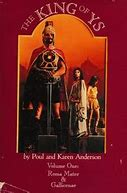In
Roma Mater, (London, 1989) Poul and Karen Anderson carefully over several chapters establish the uncanniness of Ys. A nearby military commander agrees that it is odd that curiosity has never made him visit the city. But then he mentions damnable strangeness, grisliness, witch-queens and black magic and concludes, " '...I don't want to talk about it.' " (p. 86)
By contrast, Gratillonius is drawn towards the city without knowing quite what its "...marvels..." are. (pp. 82-83) It gives him an "...eerie thrill..." when, traveling through Gallia, he realizes that some unfamiliar local words must be Ysan in origin:
"They resembled none he had heard before, but stirred vague memories in him of names he had met when studying the history of the Punic Wars." (p. 97)
The Punic Wars are relevant because he has been told that the city was a Carthaginian colony. Before this, and shortly after Gratillonius has been told that Ys has "...nine witch-queens...," we read the short Chapter V in which the Nine are active on their "...desert island..." and we learn their names - Forsquilis, Vindilis, Bodilis, Quinipilis, Fennalis, Lanarvilis, Innilis, Maldunilis and Dahilis. (pp. 86, 89)
The Ysan boundary is marked by two ten foot granite pillars, the southern column inscribed in the Ysan alphabet, which Gratillonius cannot read, the northern in Latin, which he can. The latter invokes Venus, Jupiter and Neptunus. One of Gratillonius' men asks whether those old Roman gods still have power in this place but the Centurion explains that the Latin names are merely the nearest Roman equivalents to the Three of Ys, whose real names we read in Chapter V: Belisama (see image); Taranis; Lir.
Belisama is equated to Ishtar, Isis, Ashtoreth, Aphrodite, Venus and Nerthus and called "the Star of the Sea." This title, like the name "Nerthus" and the references to the Punic Wars, resonate for readers of Anderson's Time Patrol Series.
Chapter II, set in Hivernia, mentions the Irish sea god Manandan and the Notes give his full name, Manandan maqq Leri, later Manannan mac Lir. Under the latter name, this god is a character in Poul Anderson's
The Broken Sword. "Mac Lir" means "son of the sea." The Ysan sea god is simply "Lir" - father of Manandan? Unlike Manandan, Lir is "...never given human shape..." and the description of "...three legs and a single eye, in the middle of His head...was only a way of bespeaking something strange and terrible." (p. 122)
Here we see at least two stages of religious development:
first, the worship of terrifying, uncontrollable natural forces (in the Bible, the sea represents pre-cosmic chaos, controllable only by divine power);
secondly, the deification of female and male humanity.
The stages are shown in the relative ages of the divine images. Belisama and Taranis are Roman-commissioned Greek sculptures whereas:
"The emblem of Lir was immensely older, a rough granite slab engraved with Celtic spirals." (
ibid.)
When Gratillonius first sees Ys, he reflects that it is strange that he and his father had traded so close yet he had never glimpsed the city till now. These continual references to people not visiting Ys when they could have done turn out to be significant because the city is supernaturally "Veiled."
When he first sees the high, narrow, brightly mosaiced towers shining in gold, glass and copper, made dream-like by an oceanic haze:
"He could scarcely believe that human beings dwelt yonder, not elves or Gods." (p. 104)
- a fitting culmination to all the mysterious hints in previous chapters.
In Ys, Gratillonius, a Mithraist, can do what a Christian could not, marry nine women simultaneously and become the Incarnation of Taranis. However, there are tensions between Mithras and the Three and eventually an irreconcilable conflict.
Where do the Three, or other pantheons, go when they have withdrawn? Alan Moore gives us a joke realm, the Bide A Wee Dimension for Retired Deities, but Neil Gaiman's
The Sandman series presents a more serious answer, involving the realms of Dream and
Death. See
here.










































